
Pteranodon ; from Ancient Greek πτερόν and ἀνόδων is a genus of pterosaur that included some of the largest known flying reptiles, with P. longiceps having a wingspan of over 6 m (20 ft). They lived during the late Cretaceous geological period of North America in present-day Kansas, Nebraska, Wyoming, South Dakota and Alabama. More fossil specimens of Pteranodon have been found than any other pterosaur, with about 1,200 specimens known to science, many of them well preserved with nearly complete skulls and articulated skeletons. It was an important part of the animal community in the Western Interior Seaway.

Dilophosaurus is a genus of theropod dinosaurs that lived in what is now North America during the Early Jurassic, about 186 million years ago. Three skeletons were discovered in northern Arizona in 1940, and the two best preserved were collected in 1942. The most complete specimen became the holotype of a new species in the genus Megalosaurus, named M. wetherilli by Samuel P. Welles in 1954. Welles found a larger skeleton belonging to the same species in 1964. Realizing it bore crests on its skull, he assigned the species to the new genus Dilophosaurus in 1970, as Dilophosaurus wetherilli. The genus name means "two-crested lizard", and the species name honors John Wetherill, a Navajo councilor. Further specimens have since been found, including an infant. Fossil footprints have also been attributed to the animal, including resting traces. Another species, Dilophosaurus sinensis from China, was named in 1993, but was later found to belong to the genus Sinosaurus.
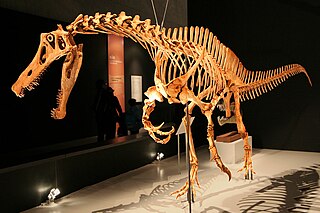
Irritator is a genus of spinosaurid dinosaur that lived in what is now Brazil during the Albian stage of the Early Cretaceous Period, about 113 to 110 million years ago. It is known from a nearly complete skull found in the Romualdo Formation of the Araripe Basin. Fossil dealers had acquired this skull and sold it to the State Museum of Natural History Stuttgart. In 1996, the specimen became the holotype of the type species Irritator challengeri. The genus name comes from the word "irritation", reflecting the feelings of paleontologists who found the skull had been heavily damaged and altered by the collectors. The species name is a homage to the fictional character Professor Challenger from Arthur Conan Doyle's novels.

Caulkicephalus is a genus of anhanguerid pterosaur from the Isle of Wight off the coast of England. It lived during the Early Cretaceous period, about 130 million years ago.

Cearadactylus is a genus of large anhanguerid pterodactyloid pterosaur from the Romualdo Formation of Brazil, South America. Fossil remains of Cearadactylus dated back to the Albian stage of the Early Cretaceous period, about 112 million years ago. The only known species is C. atrox, described and named in 1985 by Giuseppe Leonardi and Guido Borgomanero. The name refers to the Brazilian state Ceará, and combines this with Greek daktylos, "finger", a reference to the wing finger of pterosaurs. The Latin atrox means "frightful", a reference to the fearsome dentition of the species.
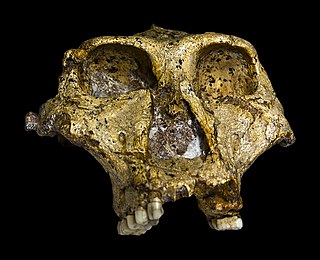
SK 48 is a fossilised skull of the species Paranthropus robustus. It was found in Swartkrans, South Africa in 1948 by palaeontologist Robert Broom. Estimated to be about 1.8 million years old, it is characterised by a robust appearance, bulging and continuous brow, broad flat face and a deep jaw with large chewing teeth/muscle attachments.

STS 71 is a fossilized skull of the species Australopithecus africanus. It was discovered in Sterkfontein, South Africa by Robert Broom in 1947. In 1972, John Wallace connected STS 71 with STS 36, a lower jaw found in the same layer, by matching the wear patterns on the teeth.
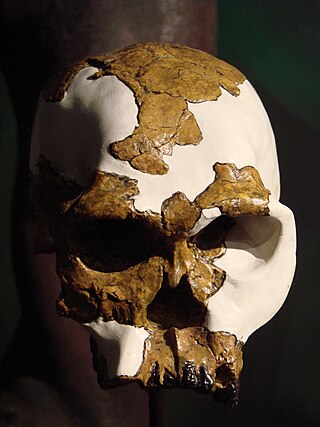
OH 24 is a fossilized skull of the species Homo habilis. It was discovered in Olduvai Gorge, Tanzania by Peter Nzube in 1968. The skull was found crushed almost flat and was therefore named after the famously skinny model of the time Twiggy. Estimated at 1.8 million years old, the cranium was found crushed flat and cemented together with a mass coating of limestone. It is now a Smithsonian exhibit item.

KNM-WT 17000 is a fossilized adult skull of the species Paranthropus aethiopicus. It was discovered in West Turkana, Kenya by Alan Walker in 1985. Estimated to be 2.5 million years old, the fossil is an adult with an estimated cranial capacity of 410 cc.

The evolution of the horse, a mammal of the family Equidae, occurred over a geologic time scale of 50 million years, transforming the small, dog-sized, forest-dwelling Eohippus into the modern horse. Paleozoologists have been able to piece together a more complete outline of the evolutionary lineage of the modern horse than of any other animal. Much of this evolution took place in North America, where horses originated but became extinct about 10,000 years ago, before being reintroduced in the 15th century.
Gorgopithecus is an extinct genus of primate in the Old World monkey family Cercopithecidae, closely related to the baboons. There is only one known species, Gorgopithecus major. It has been found at sites from the Pliocene and Early Pleistocene Epoch in South Africa and Tanzania. It was first discovered at the Kromdraai A site in South Africa. It has since been found from Swartkrans, South Africa. Most recently, it has been recognized from the DKI site in Bed I of Olduvai Gorge, Tanzania, which has been dated to 1.8 million years old.
Solimoea acrensis is a prehistoric ateline monkey from the Late Miocene Solimões Formation of Brazil. It is the only known species of the genus Solimoea.
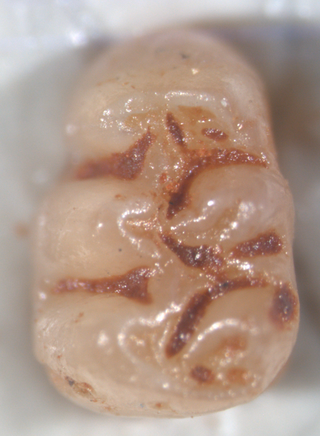
Agathaeromys is an extinct genus of oryzomyine rodents from the Pleistocene of Bonaire, Netherlands Antilles. Two species are known, which differ in size and some details of tooth morphology. The larger A. donovani, the type species, is known from hundreds of teeth that are probably 900,000 to 540,000 years old, found in four localities. A. praeuniversitatis, the smaller species, is known from 35 teeth found in a single fossil site, which is probably 540,000 to 230,000 years old.
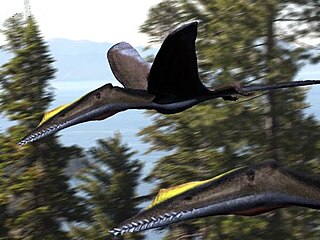
Cuspicephalus is an extinct genus of monofenestratan pterosaur known from Dorset in England. Its fossil remains date back to the Late Jurassic period.

Moganopterus is an extinct genus of ctenochasmatid pterosaur from the Early Cretaceous of western Liaoning Province, China.

Cimoliopterus is a genus of pterosaur that lived during the Late Cretaceous in what is now England and the United States. The first known specimen, consisting of the front part of a snout including part of a crest, was discovered in the Grey Chalk Subgroup of Kent, England, and described as the new species Pterodactylus cuvieri in 1851. The specific name cuvieri honours the palaeontologist George Cuvier, whereas the genus Pterodactylus was then used for many pterosaur species that are not thought to be closely related today. It was among the first pterosaurs to be depicted as sculptures, in Crystal Palace Park in the 1850s. The species was subsequently assigned to various other genera, including Ornithocheirus and Anhanguera. In 2013, the species was moved to a new genus, as Cimoliopterus cuvieri; the generic name Cimoliopterus is derived from the Greek words for "chalk" and "wing". Other specimens and species have also been assigned to or synonymised with the species with various levels of certainty. In 2015, a snout discovered in the Britton Formation of Texas, US, was named as a new species in the genus, C. dunni; the specific name honours its collector, Brent Dunn.

Iberodactylus is a genus of pterodactyloid pterosaurs belonging to the clade Anhangueria, that during the Early Cretaceous lived in the area of present Spain. The type species is Iberodactylus andreui.

Ferrodraco is an extinct genus of anhanguerid pterosaur known from the Late Cretaceous Winton Formation of Queensland, Australia, containing the single species F. lentoni. The species was named after the former mayor of Winton, Graham Thomas ‘Butch’ Lenton. It is the most complete pterosaur fossil from Australia, being known from the holotype specimen AODF 876, consisting primarily of the anterior portion of the skull and dentary, cervical vertebral centra and a partial wing. Its wingspan was estimated to be about 4 meters (13 ft). Ferrodraco was found to have been within the subfamily Ornithocheirinae, as sister taxon to Mythunga. A recent study also recovered Ferrodraco as sister taxon to Mythunga, but both placed within the family Anhangueridae, more specifically within the subfamily Tropeognathinae.
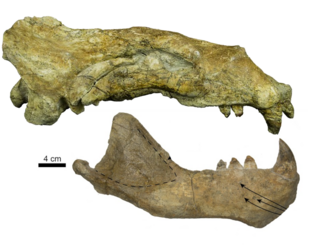
Titanotaria is a genus of late, basal walrus from the Miocene of Orange County, California. Unlike much later odobenids, it lacked tusks. Titanotaria is known from an almost complete specimen which serves as the holotype for the only recognized species, Titanotaria orangensis, it is the best preserved fossil walrus currently known.
Baguatherium is an extinct genus of herbivorous mammal, belonging to the order Pyrotheria. It lived during the Early Oligocene, and its fossilized remains were discovered in Peru.

















